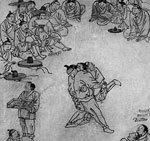Taekwondo 태권도Taekwondo Preschool
Korean martial arts are military practices and methods which have their place in the history of Korea but have been adapted for use by both military and non-military personnel as a method of personal growth or recreation.
About Han Mu Do 한무도
Korean martial arts are military practices and methods which have their place in the history of Korea but have been adapted for use by both military and non-military personnel as a method of personal growth or recreation.
Han Mu Do, founded by Dr. He-Young Kimm, is a martial arts system consisting of the study of empty hand techniques, the study of weapons, the study of ki, and the study of martial arts philosophy.
Origin
Dr. Kimm integrated the techniques and philosophies of various Korean martial arts systems, most founded in the 1950s, with new techniques into a single system. Han Mu Do was not the original name of the art the, first name, recommended by Suh In-hyuk because it had been popular in the 1950s, was Yuh Kwon Sul which means "Art of Throws and Punches." For a while, it was called Han Mu Yuh Kwon Sul, a name favoured by Ji Han Jae which means the "Korean Martial Art of Throws and Punches." Some groups from schools emphasizing ki training did not like the use of "Mu" because it meant "martial arts" and they believed that the ki training contained in Han Mu Do was more than martial arts training. They simply called it Han Do, which means "Way of Korean Martial Arts." Finally, in 1991, Kimm decided to call the art Han Mu Do. The martial art is being practised in places such as: the UK, America, Australia, Singapore, Mexico, Korea, Japan, the Netherlands and France.
Techniques
Hanmudo is a Korean martial art that is considered a "cousin" of Hapkido. Whereas Hapkido is aggressive and harder, Hanmudo can be less aggressive if need be, basically following the same tenet as Han Tae Keuk, commonly known as Korean Tai Chi. For instance, a lock applied in Hapkido is followed by a swift, hard forward motion in order to hurl or take down an opponent. Hanmudo, on the other hand, can use a pulling action together with a downward motion. This Hanmudo series of smooth moves allows to the execution of other techniques. In blocking and attacking movements, the Hanmudo motion follows the infinity sign (a figure 8 lying down).
Another difference between Hanmudo and Hapkido is in the hand techniques. Hanmudo's hand techniques are based on "soft" Korean martial arts such as Kuk Sul, Sundo and Han Tae Keuk as well as "hard" arts such as Taekwondo, Tang Soo Do, Shippalgi and Sun Mu Do. Most of the hand strikes in Hanmudo are executed with the palms open. Hapkido's hand techniques, on the other hand, are based only on the "hard" martial arts styles of Taekwondo and Tang Soo Do.
With regards to Ki training, Hanmudo and Hapkido follow different styles. Hanmudo Ki training begins with lying down and advances to a sitting then to a standing position. The final Ki training position is the moving meditation. On the other hand, Hapkido's Ki training is fixed or stationary - either in a sitting or standing position.
In terms of training with weapons, Hanmudo and Hapkido are also different. In Hanmudo, weapon training begins early into a student's training. Hapkido weapon training starts at advanced levels. The forms and styles of weapon training are also different between Hanmudo and Hapkido. To be specific, Hanmudo weapon styles are based on Muyedobotongji, a military manual from the Joseon Dynasty. There is a smooth-flowing continuity between the series of Hanmudo weapon techniques. This enables the Hanmudoist to recall and use each technique with ease. Each technique flows into another technique with ease. In addition, every Hanmudo weapon technique can be applied in any given situation. On the other hand, the sequence of weapon techniques in Hapkido is based on the founders of the Hapkido kwans or schools. Thus, the sequence of techniques in one Hapkido kwan is different from the sequence of techniques of other Hapkido kwans. This diversity in the sequence of techniques within Hapkido presents a problem and makes remembering the order of techniques difficult.
Hapkido and Kuk Sul are the basis for the Hanmudo locks. Kuk Sul locks use a larger circle similar to Wushu, while Hapkido locks use a smaller circle similar to Daito-Ryu Jujitsu. Thus, in Hanmudo, small circle and big circle locks are used depending on a given situation.
Mental and physical alignment is one notable characteristic unique to Hanmudo and not observed in other martial arts. Specifically, a Hanmudoist has to kihap (yell) in his mind, "Yu Shin Kang Kwon Han." This is done in order to coordinate his mind and let it "move" with the movements he is doing.
Hyung Sae (forms) is another characteristic that is unique to Hanmudo. The movements of Hanmudo forms follow the sequence of techniques learned. First, the forms begin with hard movements, followed by forms with both hard and soft movements, and finally forms with soft movements. Some Hapkido schools do not have forms.
A philosophy of Hanmudo that is not found in Hapkido is the character development training, which is based on the Sun Bi, the ancient Korean warriors of the Goguryeo. Penmanship (education) and Swordsmanship (Martial Art) are the focus of the Hamnudo training in character development.
When Han Mu Do students reach black belt they are usually encouraged to also train in two other martial arts, because of this it is not uncommon to see a Hanmudoist who has integrated techniques from other styles into his Han Mu Do practice.
There are five tenets defined in the International Taekwondo Federation (ITF) and several more in World Taekwondo (WT).
Perseverance ( In Nae / 인내 ): "One will persevere time and time again until they have achieved a result which is adequate towards what one was trying to achieve." View Taekwondo Tenets »
RESOURCES
This article uses material from the Wikipedia article "Han Mu Do", which is released under the Creative Commons Attribution-Share-Alike License 3.0.












